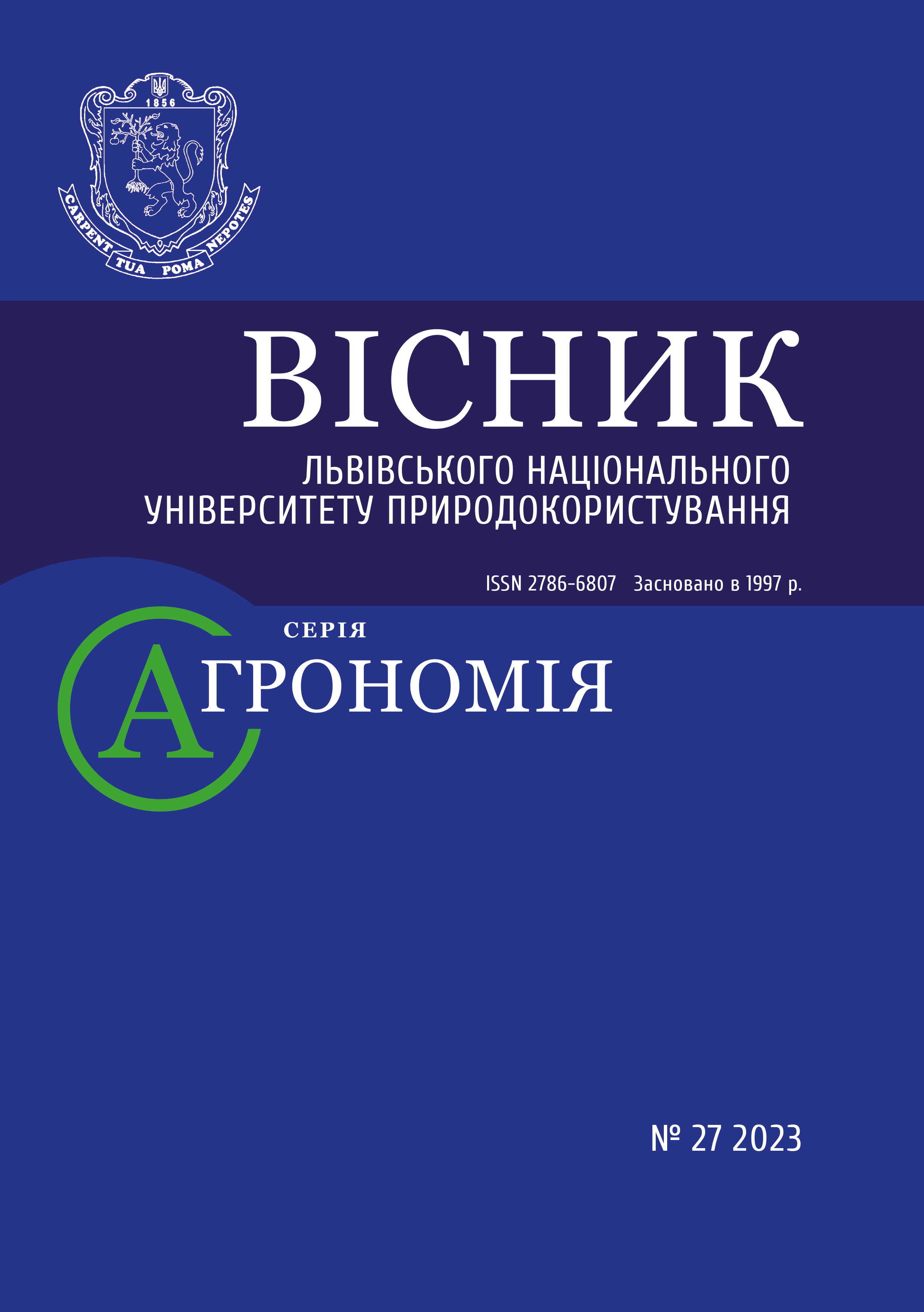IMPACT OF THE DEPTH OF WINTER WHEAT SEED WRAPPING ON ITS STRUCTURAL ELEMENTS AND YIELD
DOI:
https://doi.org/10.31734/agronomy2023.27.062Keywords:
sowing depth, winter wheat, structure, productivityAbstract
To establish the optimal depth of winter wheat seed wrapping in conditions of the Western Forest Steppe in 2018–2020, field studies were conducted on the dark-gray podsolized light loam soil of the experimental field of the Department of Technologies in Crop Production of Lviv National Environmental University. On September 30, the RZhT Reform variety was sown with a seeding rate of 3.0 million/ha and row spacing of 15 cm. The mineral fertilizer application rate was N180Р46K60. The studied depthes of seed wrapping were 1 cm, 2 cm, 3 cm, 4 cm, 5 cm, 6 cm and 7 cm.
It was established that the length of the root-like internode (distance from the primary root system to the node of the tiller) increased when the depth of seed wrapping increased and was the largest in the variant of sowing at the depth of 7 cm – 4.5 cm. The depth of seed wrapping did not affect the crop overwintering. The highest rates of field germination (90 %) of winter wheat were obtained when sowing at the depth of 2 cm and 3 cm. The same depth of seed wrapping provided proper conditions for intensification of the tillering process. The coefficient of tillering increased up to 2.4 and 2.5. The density of productive stem of winter wheat was also the highest at the sowing depth at 2 cm and 3 cm, i.e. 634 units/m2 and 652 units/m2 respectively. The mass of grain from an ear was lower (1.32–1.34 g) when sowing at a depth of 2–4 cm, which was caused by better conditions for creating higher density of ears in these variants. In the variants with a higher or lower sowing depth, the conditions for tillering were complicated, and the yield depended more on the weight of grain from the ear. To get the highest yield, the optimal combination of the main elements of the structure of productive stem density and the weight of the grain from the ear is: 634 ears × 1.34 g and 652 ears × 1.32 g per m2. The best conditions for implementation of the genetic potential of winter wheat productivity of the RZhT Reform variety and obtaining the yield of 8.22 t/ha and 8.30 t/ha are created at the sowing depth of 2 cm and 3 cm. The yield is smaller in the variants of shallow and deep seed wrapping. In the version of sowing at the depth of 7 cm, it was the smallest and amounted to 7.30 t/ha.
References
Аikins S. H. M., Afuakwa J. J., Baidoo D. Effect of planting depth on maize stand establishment. J. Ghana Inst. Eng. 2006. No 4 (2). P. 20–25.
Аkman H., Topal A. 2013 Effects on wheat root growth and development of rhizosphere environment and stress factors. J. Selcuk Univ. Nat. Appl. Sci. ICOEST Conf. Part 2. P. 824–838.
Features of the technologies of cultivation of winter grain crops for harvesting in 2020 (autumn complex of works): recommendations / Stasiv O. F., Sedilo H. M., Konyk H. S. etc. Lviv-Obroshyno. Institute of Agriculture of the Carpathian Region NAAS. 2019. 44 p.
Hadjichristodoulou A., Della A., Photiades J. Effect of sowing depth on plant establishment, tillering capacity and other agronomic characters of cereals. Journal of Agricultural Science. 1977. No 89 (1). P. 161–167. doi:10.1017/S0021859600027337.
Kalenska S. M., Karpenko L. D. Field germination of spring wheat seeds depending on the depth of sowing. Agrobiology: coll. scient. works. Bila Tserkva National Agrarian University. 2015. No 1. P. 15–18.
Kavunets V., Dvornyk V., Malasai V. Sowing depth is an important factor of yield. Land and people of Ukraine. 1997. No 2. P. 18–19.
Kyrychenko V. V., Popov S. I., Kobyzeva V. P. Peculiarities of sowing winter crops at farms of Kharkiv region for the 2019 harvest. Kharkiv: Institute of Plant Breeding named after V.Ya. Yuriev NAAS, 2018. 20 p.
Mohan A, Schillinger W.F., Gill K.S. Wheat Seedling Emergence from Deep Planting Depths and Its Relationship with Coleoptile Length. PLoS ONE. 2013. No 8 (9): e73314. https://doi.org/10.1371/journal.pone.0073314
Remeslo V. N., Kuperman F. M., Zhyvotkov L. A. Selection and varietal agrotechnolofy of intensive type wheat. Moscow: Kolos, 1982. 303 p.
Roy J., Biswas P. K., Ali M. H., Rahman A. Effect of sowing depth and population density on yield attributes andyield of wheat. Technical Journal of Engineering and Ap-plied Sciences. 2011. No 1 (4). P. 125–133.
Schillinger W. F., Papendick R. I. Then and now: 125 years of dryland wheat farming in the Inland Pacific Northwest. Agronomy Journal. 2008. No 100. P. 166–182.
Soil preparation and sowing of winter grain and oilseeds in Zaporizhzhia region in 2017 / Shevchenko I. A., Poliakov O. I., Zhuravel V. M. etc. Zaporizhzhia. IOC NAAS, 2017. 34 p.
Sokolov V. M., Bushulian O. V., Lytvynenko M. A., Linchevskyi A. A., Babaiants O. V. Recommendations for conducting a set of autumn field works at agricultural enterprises of Odessa region in 2018. Odesa: Astroprynt, 2018. 18 p.
Sowing depth and water logging time after wheat sowing affect on germination rate and seedling quality before winter / Liu Xin, Yin Chengmiao, Li Hui et al. Chinese Agricultural Science Bulletin. 2011. No 27 (3). P. 189–194.
Volkohon V. V., Moskalenko A. M., Berdnikov O. M., Yehorov O. V. Recommendations for sowing winter crops at farms in Chernihiv region for the 2016 harvest. Chernihiv: Institute of Agricultural Microbiology and Agroindustrial Production of NAAS. 2015. 28 p.
Yagmur M., Kaydan D.The effects of different sowing depth on grain yield and some grain yield components in wheat (Triticum aestivum L.) cultivars under dryland conditions. African Journal of Biotechnology. 2009. No 8 (2). P. 196–201.
Zecevic V., Boskovic J., Knezevic D., Micanovic D. Effect of seeding rate on grain quality of winter wheat. Chilean journal of agricultural research. 2014. No 74. P. 23–28. 10.4067/S0718-58392014000100004.


